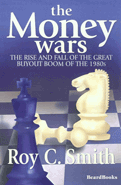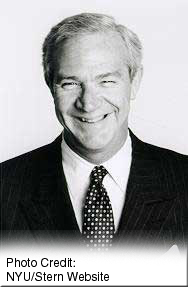|
|
|
|
||||||

|
The Money Wars: The Rise & Fall of the Great Buyout Boom of the 1980s
By Roy C. Smith 2000/05 - Beard Books 1893122697 - Paperback - Reprint - 382 pp. US$34.95 This fascinating chronicle analyzes the frenetic merger and takeover activity of the 1980s, indicating why it happened and what the effect has been on American industry and finance. Publisher Comments
A fascinating chronicle of the frenetic merger and takeover activity of the 1980s beginning with the early years of the Reagan Administration until late 1989 with the collapse of the junk bond market. These were years marked by a breed of aggressive financial entrepreneurs, such as Henry Kravis, Michael Milken, Ivan Boesky, and Boone Pickens whose incisive portraits stand out among some of the most important deals: RJR Nabisco, Beatrice Foods, Time Warner, and Macmillan, among others. From the back cover blurb: A fascinating chronicle of the frenetic merger and takeover activity of the 1980s beginning with the early years of the Reagan Administration until late 1989 with the collapse of the junk bond market. These were years in which the industrial base was catapulted on its head as a result of changing world economics, increased competition, regulatory laissez-faire, and the rise of a new breed of aggressive financial entrepreneurs, who launched the greatest wave of merger and takeover activity the county had known since the beginning of the century. Set against a historical background that compares the 80s to other periods of merger booms, The Money Wars gives a vivid account of the most important deals: RJR Nabisco, Beatrice Foods, Time Warner, Macmillan among others, as well as incisive portraits of some of the leading characters: Henry Kravis, Michael Milken, Ivan Boesky, and Boone Pickens, to name a few. More importantly, it analyzes why it happened and what the effect has been on American industry and finance. Review by David Henderson Business is war by civilized means. It won't get you a tailhook landing on an n aircraft carrier docked in San Diego, but the spoils of war can be glorious to behold. Most executives do not approach business this way. They are content to nudge along their behemoths, cash their options, and pillage their workers. This author calls those managers "inertia ridden." He quotes Carl Icahn describing their companies as run by "gross and widespread incompetent management." In cycles though, the U.S. economy generates a few business warriors with the drive, or hubris, to treat the market as a battlefield. The 1980s saw the last great spectacle of business titans clashing. (The '90s, by contrast, was an era of the investment banks waging war on the gullible.) The Money Wars is the story of the last great buyout boom. Between 1982 and 1988, more than ten thousand transactions were completed within the U.S. alone, aggregating more than $1 trillion of capitalization. Roy Smith has written a breezy read, traversing the reader through an important piece of U.S. history, not just business history. Two thirds of the way through the book, after covering early twentieth century business history, the growth of financial engineering after WWII, the conglomerate era, the RJR-Nabisco story, and the financial machinations of KKR, we finally meet the star of the show, Michael Milken. The picture painted by the author leads the reader to observe that, every now and then, an individual comes along at the right time and place in history who knows exactly where he or she is in that history, and leaves a world-historical footprint as a result. Whatever one may think of Milken's ethics or his priorities, the reader will conclude that he is the greatest financial genius this country has produced since J.P. Morgan. No high-flying financial era has ever happened in this country without the frothy market attracting common criminals, or in some cases making criminals out of weak, but previously honest men (and it always seems to be men). Something there is about testosterone and money. With so many deals being done, insider trading was inevitable. Was Michael Milken guilty of insider trading? Probably, but in all likelihood, everybody who attended his lavish parties, called "Predators' Balls," shared the same information. Why did the Justice Department go after Milken and his firm, Drexel Burnham Lambert with such raw enthusiasm? That history has not yet been written, but Drexel had created a lot of envy and enemies on the Street. When a better history of the period is written, it will be a study in the confluence of forces that made Michael Milken's genius possible: the sclerotic management of irrational conglomerates, a ready market for the junk bonds Milken was selling, and a few malcontent capitalist like Carl Icahn and Ted Turner, who were ready and able to wage their own financial warfare. This book is a must read for any student of business who did not live through any of these fascination financial eras. From Library Journal The 1980s were dominated by a new breed of capitalist and complex financial deals. Smith, author of The Global Bankers ( LJ 9/1/89), puts this activity into perspective in this comprehensive discussion of the principles and tactics of the major mergers and acquisitions of the 1980s. Smith defends these ``money wars'' as helpful to the economy and not just actions of greed. It is difficult to find a niche for this volume as it will be a rehash for those familiar with the stories, but it is also too complex for the uninitiated. Libraries desiring broad holdings in business and finance may want to purchase.-- Richard C. Schiming, Mankato State Univ., Minn. From Publisher's Weekly Smith ( Global Bankers ) believes that the merger mania and leveraged buyouts of the 1980s have been subject to ``negative exaggeration'' by critics. Citing evidence that this frenzied corporate restructuring has led to increased American productivity and competitiveness, he reviews the acrimonious buyout of RJR-Nabisco, the hostile raids on Polaroid and Time-Warner, the demise of Drexel Burnham Lambert, the bust-up of the Beatrice conglomerate and other headline-grabbing stories. From J. P. Morgan's consolidation of U.S. Steel in 1901 to the runaway '20s to the merger booms of the '60s and '80s, the record, in Smith's estimate, is clear: merger waves and bull markets tend to go together, and they involve only a relatively modest amount of GNP, even at their peaks. Smith, who teaches international business and finance at New York University, has written a challenging book that punctures many widely held assumptions about the mergers and acquisitions process. (Nov.) From Publisher's Weekly Smith reviews the buyout of RJR-Nabisco, the hostile raids on Polaroid and Time-Warner, and the bust-up of the Beatrice conglomerate as he contends that merger waves and bull markets tend to go together. PW called this "a challenging book that punctures many widely held assumptions about the mergers and acquisitions process." Copyright 1991 Reed Business Information, Inc.  Roy C. Smith, a professor of entrepreneurship, finance and international business at New York University, has been on the faculty of Stern School of Business since 1987. Prior to 1987 he was a General Partner of Goldman, Sachs & Co., specializing in international investment banking and corporate finance. He received a B.S. from the U.S. Naval Academy in 1960 and an M.B.A. from Harvard University in 1966. The author of several books on international banking including The Global Bankers, published in 1989, which has been widely acclaimed, Mr. Smith is a frequent guest lecturer at business schools in the U.S. and in Europe. He and his wife Marianna live in Montclair, New Jersey. Roy C. Smith, a professor of entrepreneurship, finance and international business at New York University, has been on the faculty of Stern School of Business since 1987. Prior to 1987 he was a General Partner of Goldman, Sachs & Co., specializing in international investment banking and corporate finance. He received a B.S. from the U.S. Naval Academy in 1960 and an M.B.A. from Harvard University in 1966. The author of several books on international banking including The Global Bankers, published in 1989, which has been widely acclaimed, Mr. Smith is a frequent guest lecturer at business schools in the U.S. and in Europe. He and his wife Marianna live in Montclair, New Jersey.
|
||||||||||||||||||||||||||||||||||||||||||||||||||||||||||||||||||||||||||||||||||||||||||||||||||||||||||||||||||||||||||||||||||||||||||||||||||||||||||||||||||||||||||||||||||||||||||||||||||||||||||||||||||||||||||||||||||||||||||||||||||||||||||||||||||
|
|
|
home
| about us
| contact us
| related
sites |